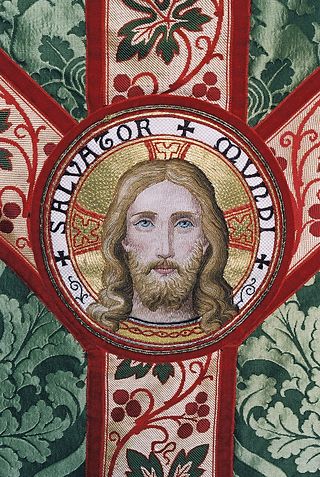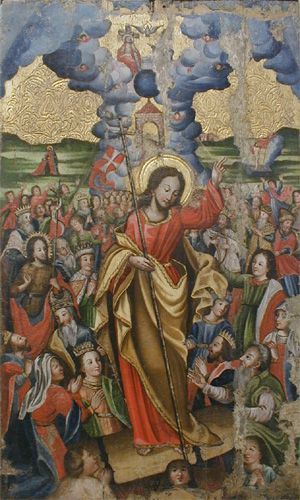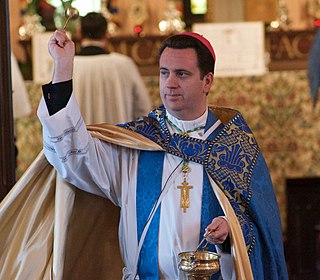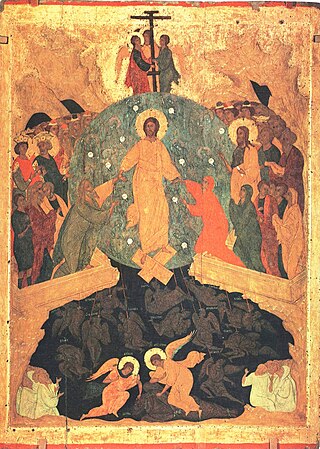
The liturgical year, also called the church year, Christian year, ecclesiastical calendar, or kalendar, consists of the cycle of liturgical days and seasons that determines when feast days, including celebrations of saints, are to be observed, and which portions of scripture are to be read.

Ordinary Time is the part of the liturgical year in the liturgy of the Roman Rite, which falls outside the two great seasons of Christmastide and Eastertide, or their respective preparatory seasons of Advent and Lent. Ordinary Time thus includes the days between Christmastide and Lent, and between Eastertide and Advent. The liturgical color assigned to Ordinary Time is green. The last Sunday of Ordinary Time is the Solemnity of Christ the King.

Septuagesima is the ninth Sunday before Easter, the third before Ash Wednesday. The term is sometimes applied to the seventy days starting on Septuagesima Sunday and ending on the Saturday after Easter. Alternatively, the term is sometimes applied also to the period sometimes called pre-Lent that begins on this day and ends on Shrove Tuesday, the day before Ash Wednesday, when Lent begins.

Holy Saturday, also known as Great and Holy Saturday, Low Saturday, the Great Sabbath, Hallelujah Saturday, Saturday of the Glory, Sábado de Gloria, and Black Saturday or Easter Eve, and called "Joyous Saturday", "the Saturday of Light", and "Mega Sabbatun" among Coptic Christians, is the final day of Holy Week, between Good Friday and Easter Sunday, when Christians prepare for the latter.

The Paschal Triduum or Easter Triduum, Holy Triduum, or the Three Days, is the period of three days that begins with the liturgy on the evening of Maundy Thursday, reaches its high point in the Easter Vigil, and closes with evening prayer on Easter Sunday. It is a moveable observance recalling the Passion, Crucifixion, Death, burial, and Resurrection of Jesus, as portrayed in the canonical Gospels.
Alleluia is a phrase in Christianity used to give praise to God. In Christian worship, Alleluia is used as a liturgical chant in which that word is combined with verses of scripture, usually from the Psalms. This chant is commonly used before the proclamation of the Gospel. In Western Christianity, congregations commonly cease using the word Alleluia during the period of Lent but restore it into their services at Easter. The form of praise "Alleluia" is used by Christians to thank and glorify God; it finds itself present in many prayers and hymns, especially those related to Eastertide, such as "Christ the Lord is Risen Today".

The gradual is a certain chant or hymn in liturgical Christian worship. It is practiced in the Catholic Mass, Lutheran Divine Service, Anglican service and other traditions. It gets its name from the Latin gradus because it was once chanted on the step of the ambo or altar. It is customarily placed after a reading of scripture.

Eastertide or Paschaltide is a festal season in the liturgical year of Christianity that focuses on celebrating the Resurrection of Jesus Christ. Preceded by Lent, it begins on Easter Sunday, which initiates Easter Week in Western Christianity, and Bright Week in Eastern Christianity.
Christian liturgy is a pattern for worship used by a Christian congregation or denomination on a regular basis. The term liturgy comes from Greek and means "public work". Within Christianity, liturgies descending from the same region, denomination, or culture are described as ritual families.

A lectionary is a book or listing that contains a collection of scripture readings appointed for Christian or Jewish worship on a given day or occasion. There are sub-types such as a "gospel lectionary" or evangeliary, and an epistolary with the readings from the New Testament Epistles.

The Epiphany season, also known as Epiphanytide or the time of Sundays after Epiphany, is a liturgical period, celebrated by many Christian Churches, which immediately follows the Christmas season. It begins on Epiphany Day, and ends at various points as defined by those denominations. The typical liturgical color for the day of Epiphany is white, and the typical color for Epiphany season is green.

Pre-Lent begins the Christian time of preparation for Easter, in the three weeks before Lent. This period launches a campaign of catechesis, reflected in the liturgical readings. Its best-known feature is its concluding three-day festival, Carnival or Shrovetide.

Asperges is the rite of sprinkling a congregation with holy water. The name comes from the first word in the 9th verse of Psalm 51 in the Latin translation which is sung during the traditional form of the rite except during Eastertide. The 51st Psalm is also one of the antiphons that may be sung in the rite under the Mass of Paul VI.

Easter Saturday, on the Christian calendar, is the seventh day of Eastertide, being the Saturday of Easter or Bright Week. In the kalendar of Western Christianity it is the last day of Easter Week, sometimes referred to as the Saturday of Easter Week or Saturday in Easter Week. It is the seventh day in the Octave of Easter too. In the liturgy of Eastern Christianity it is the last day of Bright Week, and called Bright Saturday, The Bright and Holy Septave Saturday of Easter Eve, or The Bright and Holy Septave Paschal Artos and Octoechoes Saturday of Iscariot's Byzantine Easter Eve. Easter Saturday is the day preceding the Second Sunday of Easter.

Easter Friday, or Bright Friday, is the sixth day in the Christian season of Eastertide. At times, this name has been confused with Good Friday, which falls a week earlier.

A liturgical book, or service book, is a book published by the authority of a church body that contains the text and directions for the liturgy of its official religious services.
The Second Sunday of Easter is the eighth day of the Christian season of Eastertide, and the seventh after Easter Sunday. It is known by various names, including Divine Mercy Sunday, the Octave Day of Easter, White Sunday, Quasimodo Sunday, Bright Sunday and Low Sunday. In Eastern Christianity, it is known as Antipascha, New Sunday, and Thomas Sunday.

Pentecost season, also known Pentecostide, as well as the time of Sundays after Pentecost or Sundays after Trinity, is a liturgical period, celebrated by some Christian churches, which immediately follows the Easter season. Although the start and end dates vary by liturgical tradition, the season typically begins on the day of Pentecost and continues throughout the rest of the liturgical year, ending just before the season of Advent. The liturgical color for this period is typically green or red.
The Third Sunday of Easter or Third Sunday of Eastertide is the third Sunday of the Easter season, being the day that occurs two weeks after the Christian celebration of Easter Sunday. It is also known as Good Shepherd Sunday.
The Fourth Sunday of Easter is the fourth Sunday of the Easter season, being the day that occurs three weeks after the Christian celebration of Easter.
















